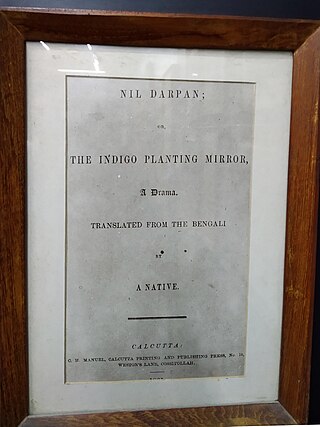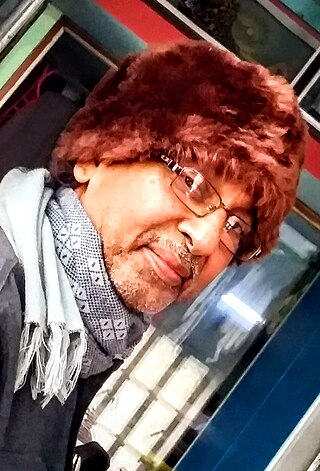Related Research Articles
Mahishya is a Bengali Hindu traditionally agrarian caste, and formed the largest caste in undivided Bengal. Mahisyas were, and still are, extremely diverse caste consisting of all possible classes in terms of material conditions and ranks.
Gobindram Mitter was one of the earliest Indian officials during the Company rule in India, who earned reputation for his wealth and extravagance.

Pramod Ranjan Choudhury was a Bengali activist for the Indian independence movement who was hanged for the assassination of police officer Bhupen Chatterjee.

Dinabandhu Mitra, also known as Denobhandhoo Mithra, was a Bengali writer and dramatist. He is notable for his play Nil Darpan (1860).

Nil Darpan is a Bengali-language play written by Dinabandhu Mitra in 1858–1859. The play was essential to Nil Vidroha, better known as the Indigo Revolt of February–March 1859 in Bengal, when farmers refused to sow indigo in their fields to protest against exploitative working conditions during the period of Company rule. It was also essential to the development of theatre in Bengal and influenced Girish Chandra Ghosh, who in 1872 would establish the National Theatre in Calcutta (Kolkata), where the first play ever commercially staged was Nildarpan.

The Indigo revolt was a peasant movement and subsequent uprising of indigo farmers against the indigo planters, that arose in Bengal in 1859, and continued for over a year. The village headmen (Mandals) and substantial ryots were the most active and numerous groups who led the peasants. Sometimes disgruntled former employees of European planters - 'gomashta' or 'diwan' of the Indigo factories, took the lead to mobilise the peasants against the Indigo planters.
The Hindoo Patriot was an English weekly published from Calcutta in the later half of the nineteenth century in Bengal.
Khagendranath Mitra (1896–1978) was a writer for children of Bengal. Even today his writings continue to be popular among children and preteens.

Arup Chandra, born in 1951 in Murshidabad district in the state of West Bengal, is a writer, poet, essayist, art critic, and an educator. He is the writer of more than fourteen books, and has edited twelve others. Two of his books are translated into English and published. His research speciality is the history, poetry, art, culture and literature of Murshidabad District.
Srish Pal was a Bengali revolutionary, born in Mulbarga, Dacca, British India. His full name was Shrish Chandra Pal. He was attracted to revolutionary politics in 1905 with the guidance of Hemchandra Ghosh. He joined the Dhaka-based Mukti Sangha. Pal was a follower of Netaji Subhas Chandra Bose.
Palashipara, is a village in the Tehatta II CD block in the Tehatta subdivision of the Nadia district, West Bengal, India.
Asannagar is a village and a gram panchayat in CD block in the Krishnanagar Sadar subdivision of the Nadia district in the state of West Bengal, India. It was formerly under Kotwali Police Station but now it is under newly formed Bhimpur Police Station.

Radharaman Mitra was a revolutionary involved with Meerut Conspiracy Case and Bengali writer. In 1981 he received Sahitya Akademi Award for his book Kalikata Darpan.
Pramod Ranjan Sengupta প্রমোদরঞ্জন সেনগুপ্ত was a Marxist intellectual and Bengali revolutionary, attached with of Indian National Army led by Netaji Subhas Chandra Bose.

Santosh kumar Mitra or Santosh Mitra was an activist of the Indian independence movement and a martyr.

Anantahari Mitra was a Bengali Indian independence movement activist.
Dhirendralal Dhar was a Bengali writer. In 1979, he received the Indian National Award for his contributions to Children's literature. His pen name was Shridhar Munshi.
Satish Sardar or Satish Chandra Sardar was a Bengali revolutionary and martyr of the civil disobedience movement in Bengal.
Kalikrishna Mitra was a Bengali philanthropist, educator and writer. He established the first non-government girls’ school in India.
Haridas Dutta was a Bengali revolutionary involved with Rodda company arms heist case.
References
- ↑ Rāẏa, Suprakāśa (1999). Peasant Revolts and Democratic Struggles in India. ICBS (Delhi). ISBN 978-81-85971-61-2.
- 1 2 Vol I, Subodh C. Sengupta & Anjali Basu (2002). Sansad Bangalim Charitavidhan (Bengali). Kolkata: Sahitya Sansad. p. 356. ISBN 81-85626-65-0.
- ↑ "THE 1857 REBELLION: A PRE-HISTORY". March 4, 2007. Retrieved February 25, 2018.
- ↑ "District Census Handbook, North 24 Parganas" (PDF). censusindia.gov.in. p. 9. Retrieved February 25, 2018.
- 1 2 Pinaki Biswas (2014). Seisob Shahidera (Bengali). Kolkata: Atirikto Publication. p. 14. ISBN 978-81-928741-0-4.
- ↑ History. "Chapter III" (PDF). nadia.gov.in. Retrieved February 25, 2018.
- ↑ "SOCIAL MOBILITY: A MULTIDIMENSIONAL ANALYSIS" (PDF). p. 117. Retrieved February 25, 2018.
- ↑ Suprakash Roy (1972). Bharater Krishak Bidroho O Ganatantrik Sangram (Bengali). Kolkata: DNBA Brothers. pp. 212, 213.
- ↑ Khagendranath Mitra (1999). Dakait Omnibus (Bengali). Kolkata: Bharati Sahitya Prakashani. pp. 7, 24.
- ↑ Dhirendralal Dhar (1990). Nilkar Elo Deshe. Kolkata: Dey's Publishing. ISBN 81-295-0704-8.